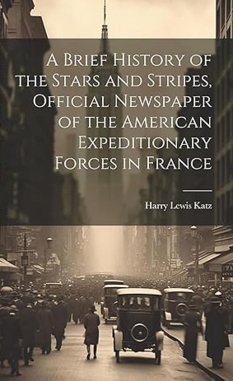Written during the closing days of the paper's existence, the reporting journalist could not emphasize enough how lousy the paper was with enlisted men serving in the most important positions. You will come away with a good amount of knowledge concerning the manner in which The Stars and Stripes crew addressed their daily duties and still made it to the presses on time. Surprising is the high number of experienced newspapermen who wrote for the paper during the paper's short existence.
Sergeant Alexander Woollcott (1887 - 1943) wrote this article so that his New York readers (whom he had not addressed since signing on with the Doughboys) would know the key roll Corporal Harold Ross (1892 - 1951) played as Managing Editor at the Paris offices of The Stars & Stripes. Anyone who glances at those now brittle, beige pages understands how sympathetic the The Stars & Stripes and their readers were to the many thousands of French children orphaned by the war; Woollcott makes it clear that it was Harold Ross who was behind the A.E.F. charities that brought needed relief to those urchins.
"It seems certain that no man in the A.E.F. had a greater influence on it's thought and spirit...The men who worked with him on The Stars & Stripes considered him the salt of the earth." To read another W.W. I article by Alexander Woocott, click here. If there was any mascot who best represented the staff of the old Stars and Stripes, it would have been their primary cartoonist (even though he was a Marine), Abian Wallgren (1892 - 1948) - who went by the name, "Wally". Looking back 20 years, Wally remembers how he got started as a cartoonist and what Armistice Day was like at the paper's office.
An article by The American Legion Weekly correspondent Rex Lapham about the last issue (until the next war) of The Stars and Stripes. The article recorded many sentimental remarks, words of praise and seldom heard facts about the history of the Doughboy newspaper.
"If the paper found it's way across, as it surely did, into the hands of the German intelligence officers - if that's what they could be called - it must have given them something to ponder about. How could they have reported anything favorable to the ears of the German high command after having perused this defiant and determined manifestation of Doughboy psychology?"
Click here to read how the newspaper was staffed and managed in 1918 Paris. The battle of Cantigny (May 28 - 31, 1918) was America's first division sized engagement during the First World War; George Marshall would later opine that the objective was "of no strategic importance and of small tactical value". General Pershing was hellbent on eradicating from the popular memory any mention of the A.E.F.'s poor performance at Seicheprey some weeks earlier, and Cantigny was as good a battleground in which to do it as any. Assessing the battle two weeks after the Armistice, Pershing's "yes men" at the Stars & Stripes wrote:
- from Amazon:

"But at Cantigny it had been taught to the world the significant lesson that the American soldier was fully equal to the soldier of any other nation on the field of battle."
Click here to read about the foreign-born soldiers who served in the American Army of the First World War.
Click here to read a STARS & STRIPES article about the sexually-transmitted diseases among the American Army of W.W. I...
The American performance at the battle of Chateau-Thierry proved to General Foche that the Americans had the necessary stuff, and it was widely recognized that the Doughboys played the key roll in keeping the Germans out of Paris. The attached STARS AND STRIPES article is extremely detailed as to the individual units (both French and American) that participated in rolling back the Germans along the Marne. "On June 4, the best information available indicated that the enemy was employing not less than 33 divisions, about 3000,000 men...But like the defenders of Verdun, the American machine gunners set their teeth and said, 'They shall not pass.'" |